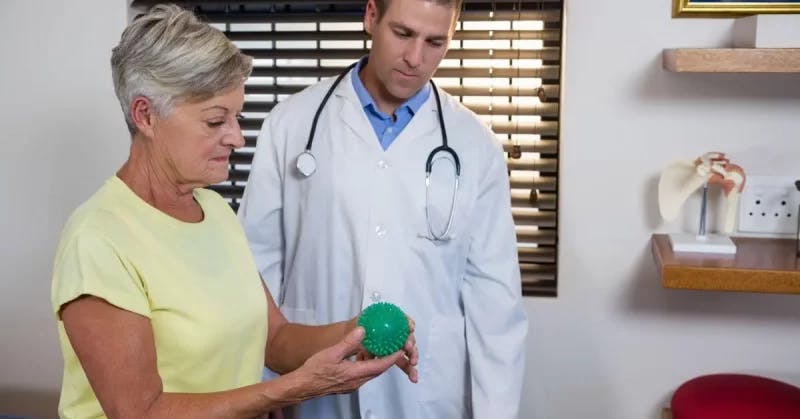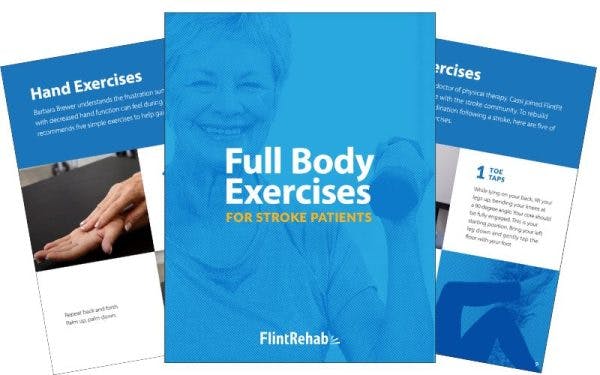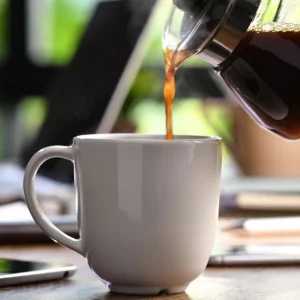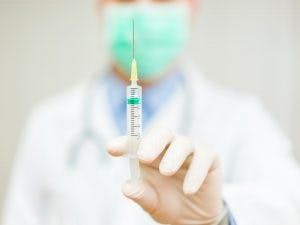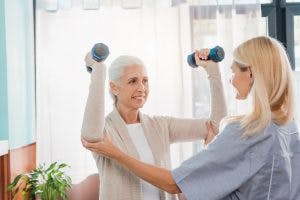Proprioception, or body awareness, can be impaired after a stroke. This deficit makes everyday tasks more challenging in a mysterious way because coordination can be impaired while strength is unaffected.
But there’s good news.
With the right exercises and strategies you can improve your proprioception which in turn helps accelerate your recovery. In fact research shows the important role proprioception plays in recovery of function after a stroke. and return to normal daily activities.
In this article, we will define proprioception and explain its important role for recovery after stroke. In addition, we will outline a variety of strategies for stimulating the development of proprioceptive skills and the role new technology can play in rehabilitation of your proprioceptive areas of the brain.
Understanding Proprioception and Its Importance After Stroke
Proprioception is your body’s ability to sense joint position and limb movement. Because of proprioception, a person is aware of their body’s position in space without the sense of touch, sight, or any other senses. For example, this is what allows you to touch your nose with your eyes closed or walk without constantly looking at your feet.
This sense is mediated by sensory receptors in your muscles, joints, and skin that send signals to your brain about your body’s position in space. And when these signals are disrupted, as they often are after a stroke, it can lead to difficulties with:
- Balance and coordination: You might feel unsteady on your feet or have trouble coordinating your movements.
- Movement accuracy: Reaching for objects or stepping over obstacles is challenging without use of your vision. .
- Postural control: Maintaining good posture can be reduced, increasing your risk of falls.
Improving proprioception will result in more fluid movements. In fact, research is revealing that stroke survivors with intact proprioception rehabilitate better than those with impaired proprioception.
How Stroke Affects Proprioception
A stroke can disrupt proprioception in several ways including:
- Damage to the brain: If the stroke affects areas of the brain responsible for processing sensory information, it can impair proprioception.
- Sensory loss: Sensory receptors transmit signals to sensory processing areas of the brain.A stroke can also cause sensory loss from specific body parts, making it difficult to sense their position and movement.
- Weakness and paralysis: Muscle weakness or paralysis can also affect proprioception over time. As the brain receives less information from affected limbs, it atrophies and loses some capacity.
The severity of proprioceptive deficits varies depending on the location and extent of the stroke. However, even mild impairments can significantly impact daily activities.
Strategies to Improve Proprioception After Stroke
Improving proprioception after stroke requires consistent effort and targeted exercises. Here are just a few strategies that can put you on the right track to regain your body’s awareness:
1. Sensory Stimulation Exercises
These exercises can help improve proprioception after stroke by activating the proprioceptive receptors in your muscles, joints, and skin. This in turn can stimulate the sensory areas of your brain.
Some of these exercises include:
- Weight-bearing exercises: Leaning on the affected arm while standing at a table provides enhanced input to the wrist, elbow and even shoulder joints. The added weight leads to heightened stimulation of receptors and therefore increased signally to the cerebral cortex. Activities like standing, walking, and stair climbing provide your brain with valuable proprioceptive input. Start with supported exercises and gradually progress to unsupported ones as your balance improves.
- Joint compression: Applying gentle pressure to your joints similarly enhances stimulation to the cortex by engaging proprioceptors. You can do this by leaning on a table, squeezing a ball, or performing exercises with resistance bands with eyes closed.
- Texture discrimination: Try identifying different textures with your eyes closed. This can help retrain your brain to process sensory information from your hands and feet.
- Rehabilitative Technology: Games that require use of your limb with little or no reliance on visual engagement are very good at stimulating this part of your brain. The Music Glove and Fit Mi pucks are affordable devices for this kind of stimulation. Similarly other rehabilitation robotic devices such as Armeo Spring have even more options to challenge you to move purposefully without visually tracking your limb.
2. Movement Awareness Exercises
Movement awareness exercises are another great way to improve proprioception after a stroke. Some examples of movement awareness exercises can include:
- Mirror therapy: Using a mirror to observe your movements can help your brain re-learn how to control your body. This technique is particularly helpful for individuals with visual neglect.
- Mental imagery: Visualizing yourself performing movements reinforces those areas of your brain that have lost some function from the stroke. Close your eyes and imagine yourself walking, reaching, or performing other activities.
- Tai chi and yoga: These practices involve slow, controlled movements that require some body awareness. This is an excellent way to develop and improve your proprioception in all limbs. Consequently many report improved balance and coordination.
3. Balance and Coordination Exercises
Improving balance and coordination goes a long way towards regaining functional independence. While there are numerous exercises for recovering balance after stroke, they can generally be broken into categories that include:
- Static balance exercises: Start by practicing standing on one leg or maintaining your balance on an unstable surface like a wobble board.
- Dynamic balance exercises: Progress to exercises that challenge your balance while moving, such as walking heel-to-toe or navigating an obstacle course.
- Coordination exercises: Activities like throwing and catching a ball or performing hand-eye coordination drills can help improve your motor skills while improving your balance.
Depending on your level of restriction you may want to start with balance and work your way to more dynamic based exercises.
4. Assistive Devices and Adaptive Strategies
Finally, if your loss of sensation is significant enough to limit your independence, assistive devices or adaptive strategies may be needed. Simply put, they can compensate for proprioceptive deficits and allow you to perform daily tasks more safely.
Some examples of assistive devices and adaptive strategies include:
- Orthotics and braces: AFO foot drop braces and other devices can provide support and stability, improving your balance and reducing your risk of falls.
- Canes and walkers: These mobility aids can help you maintain your balance while walking.
- Adaptive equipment: There are a long list of devices to make daily life easier for you. Ask your Occupational Therapist for advice, but be aware that adaptations of the home that facilitate your independence will not limit your opportunity for growth, but increase it. Consider how adaptive equipment, such as grab bars, dressing aids, and non-slip surfaces make your home environment safer so you are less hesitant to do more.
Tips for Maximizing Proprioceptive Recovery
Recovering proprioception requires doing exercises consistently. To maximize your recovery and regain control of your body, here are a few key tips to consider:
- Consistency is key: Make proprioceptive exercises a regular part of your rehabilitation program. Aim for 30 minutes of practice most days of the week.
- Start slowly and gradually increase the difficulty: Don’t push yourself too hard, especially in the early stages of recovery. Gradually increase the duration and intensity of your activities as your proprioception improves.
- Focus on quality over quantity: Although quantity is important for stimulating the cerebral cortex enough so that it will adapt and grow, if you are targeting sensory stimulation, be sure you do the activities that increase joint awareness. Consult your therapist to make sure you learn well which are the best exercises for you. Pay close attention to your body’s signals and stop if you feel pain.
- Incorporate proprioceptive exercises into daily activities: Look for opportunities to challenge your proprioception. Close your eyes while using your hands for a task. Practice your balance and coordination throughout the day. For example, try standing on one leg while brushing your teeth or reaching for objects out of sight.
- Work with a qualified therapist: A physical or occupational therapist can assess your proprioceptive deficits and develop a personalized exercise program to meet your needs.
Remember, everyone recovers at their own pace. Stay consistent and you will continue to improve and eventually reach your full potential.
The Role of Technology in Proprioceptive Rehabilitation
Technological advancements have led to the development of innovative tools for proprioceptive rehabilitation. Some are especially good at challenging you to move to a target with no visual guidance so that you are relying entirely on your proprioception to have success at the game. Some new technologies that can help improve your proprioception after stroke include:
- Virtual reality (VR): VR technology can create immersive environments that challenge balance and coordination in a safe and engaging way.
- Robotic devices: Robotic devices can assist with movement and provide feedback on performance, helping to improve proprioception.
- Wearable sensors: Wearable sensors can track movement and provide real-time feedback on body position, helping to increase awareness.
- Music-based Therapy: Game-like therapy that works on multiple levels including auditory cueing, rhythm, and timing to retrain the brain and body.
These technologies offer new possibilities for personalized and effective proprioceptive rehabilitation after stroke. Often they facilitate increased range and time spent moving both of which lead to more opportunities for neuroplasticity of the brain.
The Importance of Patience and Persistence
Recovering proprioception after a stroke takes time and dedication. Don’t get discouraged if results come slowly. Focus on making consistent efforts, and celebrate your achievements along the way.
Remember, you’re not alone on this journey. With the right support, strategies, and mindset, you can improve your proprioception and regain control of your body.
